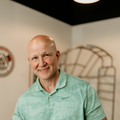Americans spend $50 billion in healthcare costs per year for low back treatments. When adding lost wages and decreased productivity, the number rises to over $100 billion per year. Low back pain is at epidemic levels in the U.S. Chances are great that you will experience low back pain sometime through your life. So if you are currently suffering or want to prevent problems before they become a reality, this information may be invaluable to you.
If the low back could speak, most of the time, it would say, "I am not the problem." The low back is the crossroads of the body. Forces and motion generated from the lower body and upper body must cross through the low back. Usually not a problem unless the forces become too great. Suppose the relative motion between the individual bones in the low back becomes excessive. Then pain is inevitable.
Why then does the body so often get forced into this self-destructive behavior? To better understand why the body is failing so often, we must understand that we come from hunters and gatherers. From our genome's perspective, our hunting and gathering days were just seconds ago. When we see those cultures in the world today, they cover around 12-18km per day. They rarely sit; they instead squat or lay down. Now enter into modern life where most of the day is sitting. The foot is not engaged with its environment like hunter-gatherer societies. Instead, the modern foot is covered and walking on hard, level, man-made surfaces.
For example, people who sit the longest, for example, truck drivers, have two and half times the national average for low back pain. This is because the mid-back tends to hunch forward as we sit, and the arms are almost always positioned in front of us. This posture keeps our shoulder blades fixed in the same relative spot. As a result, Hunter-gatherer shoulder blades move all over their rib cage to meet their daily needs.
As the shoulder blades are fixed forward, and the mid-back is rounded, our head and chin are almost always jet forward. This compounds the stress in our neck and also our low back. See next paragraph for load changes.
Lumbar disc pressures vary greatly by body position. For example, laying flat on your back causes 25kg of pressure; there is 100kg with standing, 150kg with sitting, and 185kg with sitting and slouching forward.
Hopefully, you are starting to see that not moving in similar ways as our ancestors has real consequences. Remember, the low back is the crossroads of the body. When the best friends to the low back are ineffective, it throws much more motion and/or greater loads into the lumbar spine.
Low back success is dependent on other parts that may be symptom-free but who are not carrying their load. Some of the most likely culprits to low back pain are the foot and ankle, hips, thoracic spine, areas in the spine where ribs attach. Why are these areas more likely to throw added loads onto the lumbar spine? They all have a remarkable ability to move, especially in rotation. This is critical because when they lose their ability to move, especially rotate, it forces the low back to absorb the additional motion. The motion the low back is least qualified to absorb is rotation.
The key to resolving low back pain is finding areas that do not contribute adequate motion and/or control. This is something we take great lengths to uncover at Eastside Wellness Chiropractic. For the motion to be effective, it will need to be tested in two different ways. First, we must establish if the point has an adequate range of motion in all three planes. Second, we must control those motions in all three planes. Both parts must exist to own a given motion.
For this reason, I broke the hip videos into both range of motion and stability. By improving the function of the hips, you will go a long way in reducing current and preventing future low back pain.
There is a series of exercises on our website and youtube channel for both mobility and stability of the foot.
References:
1. America Chiropractic Association, 2020 Statistics
2. Stacy Hackner, Bio




